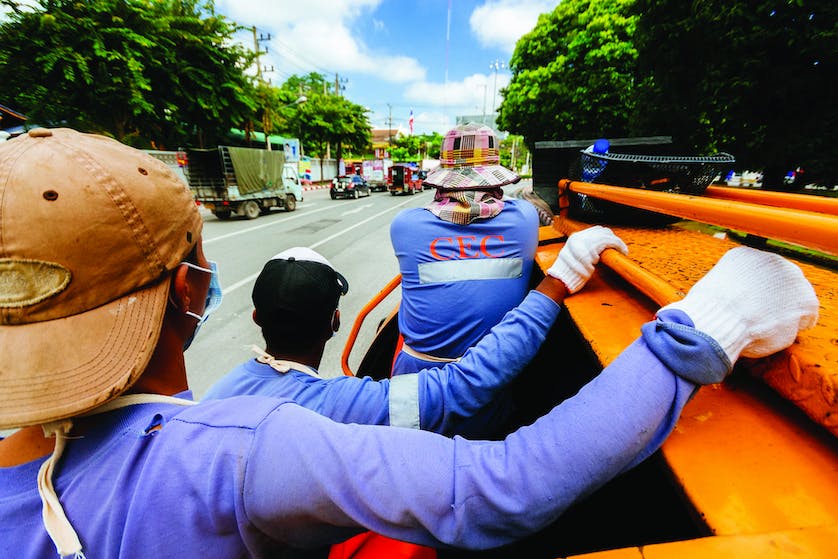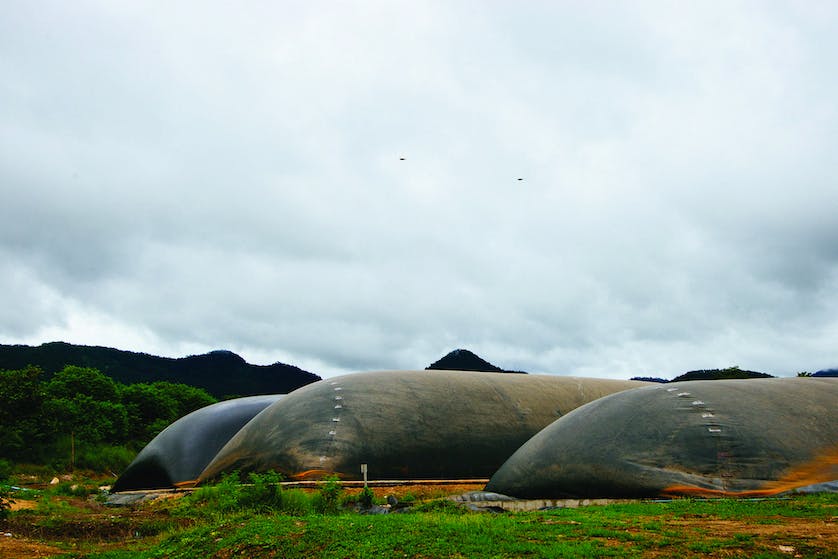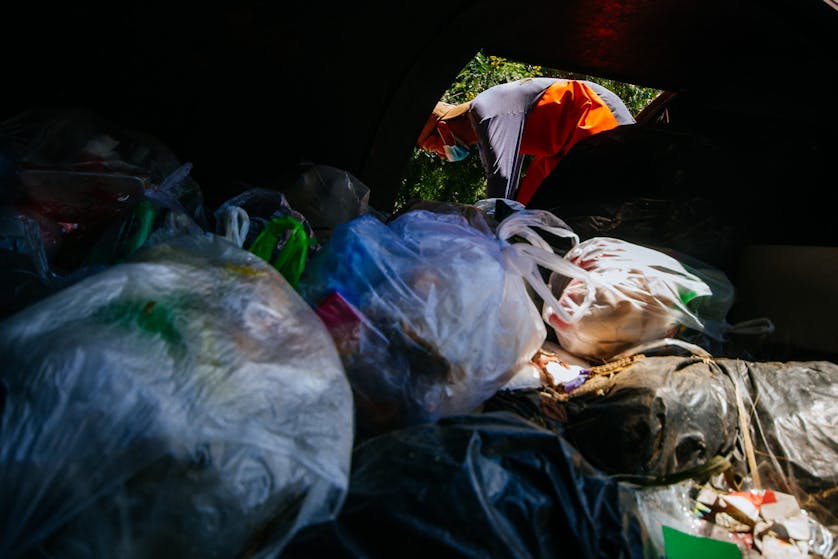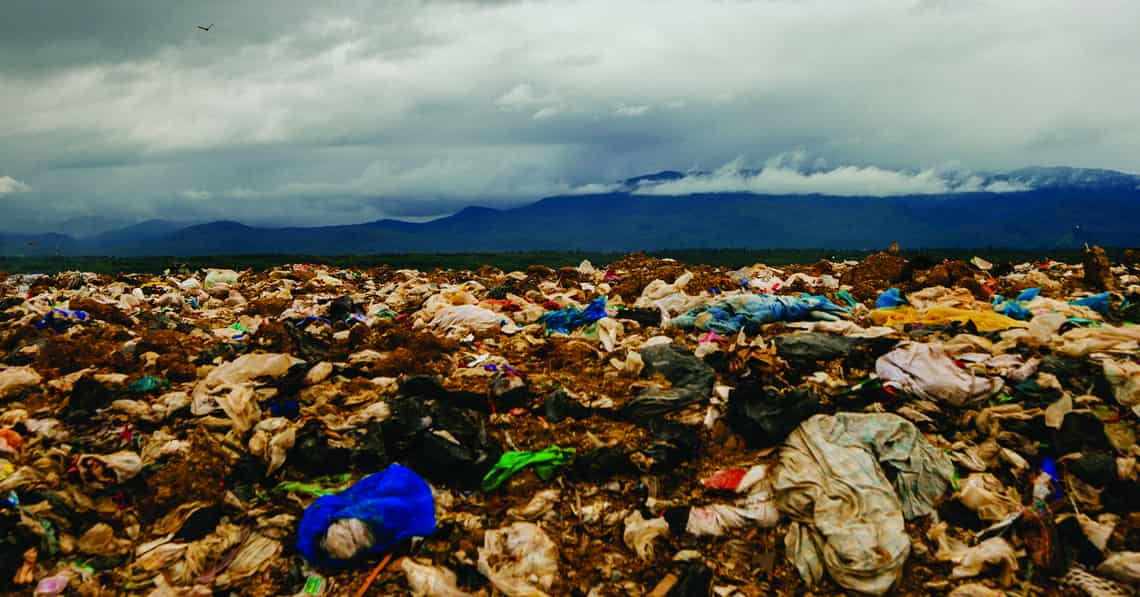Most nights I wake up in the early hours to the familiar sounds of my neighbours’ dogs barking followed by the deep roar of an engine and the clanging of metal. I go back to sleep, knowing that the garbage collector has taken away yesterday’s rubbish and I give it no further thought until I wake from slumber another night to the same sounds. Like most of you, I dare say, I don’t give much thought to what happens once my rubbish has been collected, assuming it ends up somewhere far away and that someone is sorting it all out. But this month I got curious and decided to look into how much garbage we produce as a city, who manages it, where it goes and generally sticking my nose into some stinky business.
“In Chiang Mai city alone we produce 300 to 320 tonnes of solid waste each day,” Prasopchai Khaek-oi, Sanitary Engineer, Chiang Mai Municipality told me when I began to look into the matter. “That’s only the amount collected by the rubbish trucks, and doesn’t include all the junk littered around or illegally dumped, which could hike the number up to 400 tonnes.” This vast amount of garbage must be systematically collected, sorted, transported to a site and managed. I realised that I had a lot to learn, so I decided to go back in time to see how we got to where we are, before I could then find out where we need to go.
A Bunch of Old Rubbish
The 1990s saw the city face some serious garbage issues, with one strike in 1994 seeing the entire city turning into a rotting garbage dump for weeks on end, as the municipality struggled to find solutions. “Our rubbish used to be dumped in Doi Saket, Mae Hia and San Sai, but the residents in those areas had had enough of the smell and the vermin, so they didn’t allow this anymore. Suddenly there was nowhere to go and the city was flooded with rubbish which caused a huge stink,” said Assanee Buranupakorn, Secretary to the Mayor of Chiang Mai Municipality. “When the new mayor Pakorn Buranupakorn came to office he found a new location and signed a contract with a private company to dump the city’s garbage in a sanitary landfill in Hot District, 115 kilometres away from the city. And that’s still where your rubbish ends up today.”
Prior to the ‘90s our city’s waste was shoddily dumped in nearby districts, much to the outrage of local residents. It wasn’t until the 7th National Economic and Social Development Plan of 1992 stated that it would prioritise environmental issues that any concern was given to the matter. For the first time, due to pressure from the Pollution Control Department and the Ministry of Environment and Natural Resources, Chiang Mai authorities were forced to manage the city’s waste.
The waste management issue erupted again in October 2004 when the contract expired and residents near the dump site protested against the deposit of rubbish in their area. It is speculated that the issue arose from conflicts over interests, since all was soon resolved when the mayor at that time Boonlert Buranupakorn (of the same family as the previous as well as current mayor…and his secretary), moved to a neighbouring disposal site. However, it was found that some rubbish was reportedly being sneaked to other dump sites closer to town, causing mass protests in Chiang Mai and Lamphun. In spite of the turmoil, the Ban Tarn landfill re-opened in 2007 and the rubbish issue has since abated. The municipality has outsourced waste management to two companies, one of which is responsible for its collection and the other for its disposal.
Snapper Up of Unconsidered Trifles
The current system today may not appear sophisticated, but it does work surprisingly well, considering the limitations. Once you have bagged and dumped your rubbish in the bin outside your house, people will appear on motorbikes with sidecars to rummage through it all. These people are called saleng and they are an integral part of the rubbish ecosystem, so to speak. They search for plastic bottles, paper and other recyclable materials that they then sell to bulk buyers. This is the first layer of recycling, as most households don’t make much, if any, effort in this regard. One of 47 garbage trucks which belongs to Chiang Mai Rimdoi CRC – CEC, now in its second five -year concession with the municipality, will then take it all away on one of its 140 daily rounds. This is where the second sorting happens, as the men on the trucks will often choose to separate more items for sale. The third sorting happens at the Haiya Transfer Station.

“You see? It’s not that bad,” smiled Sungworn Longmanee, 64, the driver of the rubbish truck I was hitching a ride with for the day. We were driving past Muang Mai Market and while the men at the back of the truck were busy doing their jobs, Sungworn was chatting with and waving to local vendors, all of whom he seemed to know by name. “I come here every day and we always have a nice little chat. We laugh and we smile. It’s not a bad way to start the day is it?” he asked.
“Many of these market sellers know what time I will arrive and as you can see, they will bring me their rubbish,” explained Sungworn while skilfully and cheerfully reversing down a harrowingly narrow and crowded market alley. “Most trucks start their daily round around midnight and will finish around 10am, but for crowded places like the markets and some big hotels like Anantara we need to collect their rubbish twice a day.”
“I really can’t say which particular areas produce the most rubbish. It’s just a lot everywhere and it is all over the place, literally. We do our best to collect everything because if we miss a spot there are inspectors who drive around to catch and fine us. It is quite difficult as some people just dump their rubbish any time of the day they feel like it. That’s why we have to go to the markets twice a day, to make sure the streets are cleaned,” he added.

“Collecting rubbish is a time constraining task as we try to have the street cleared by 8am each day,” explained Prasopchai. We ask people to dump their rubbish after 6pm each day so that we can have it cleared by the next morning. But not everyone does what we ask.”
Managing waste is costly. Interestingly enough it costs only 40 baht per month to pay the municipality to come and collect garbage from your bin. Even so, most households won’t comply, choosing to dump their waste in their neighbours’ bins instead. Chiang Mai municipality spends over 200 million baht, about 12% of its annual budget, to manage the city’s waste with half that budget going towards the collection process which includes separating the waste by using separate trucks for general waste, infectious waste from the hospitals, hazardous waste or electronic waste, garden waste, and old furniture.
“Thais are not taught to separate waste,” said Prasopchai. “It’s just not in the consciousness of our people to separate the wet waste and the dry waste, let alone anything more complex. Another reason we don’t have more bins is that we can’t place five different types of separate rubbish bins in front of people’s homes like they do in Europe or Japan. We want to, but it’s virtually impossible to get someone to put one bin in front of their house, let alone four or five. The problem is that we are in the tropics and our waste creates pungent smells as well as attracts vermin, so no one wants that in front of their house. Can you imagine a row of five of them?!”
“We are trying to control the amount of waste so as to control the cost of disposing,” said Assanee. “About 10 tonnes per day of garden and food waste is sent to the Rama IX Garden to make fertiliser which is later distributed to the local people for free and used in our public parks. Hazardous waste like light bulbs and batteries are sent to be destroyed once a year which costs 10,000 baht per tonne. There are about 37 tonnes a year and the 220 tonnes per year of infectious waste is sent separately to the incinerator at Chang Phueak Cemetery. That way we are able to control the budget which currently costs us a very expensive 900 baht per tonne, this is mainly due to the distance to Hot.” At 300 tonnes a day, that works out at roughly 8.1 million baht a month just for disposing waste in a landfill.
Not a Hot Mess
According to the Pollution Control Department, the Ban Tarn Sanitary Landfill in Hot takes in about 600 tonnes of waste each day from 39 local administrative organisations, of which 28 are from the Chiang Mai province including Chiang Mai municipality, 8 from Lamphun, 2 from Chiang Rai, 1 from Mae Hong Son and 8 private companies that collect rubbish from housing estates.
After spending the morning with the jovial Sungworn, I was eager to continue my rubbish adventure. And so it was that I found myself one sunny day getting lost in the longan-filled hinterlands of Hot. After asking a few villagers for help, we found ourselves pleasantly surprised by the grand sight of our dump site.
“In this 2,000 rai area, there are four companies making the best out of the rubbish that is dumped,” said Rudtanavalee Suetrakun, an Environmental Engineer of Tha Chiang Tong Company, one of the firms producing electricity from landfill gas. “We have the company which owns the landfill, two companies that produce electricity from the landfill gas and another firm using the heat generated to produce dried longan.”
I was a bit relieved to find that it wasn’t just an area with a big dirt hole in the ground. The pit is covered with 1.5 mm high-density polyethylene and compressed with clay before it is allowed to be used as the landfill. “The old landfill which is completely filled already covers an area of 150 rai and the current one that we are using is about the same size. The methane gas produced from the landfill, once cleaned, is being distributed to about 200 households in the nearby area. The waste water from the landfill is also treated and used as a liquid fertiliser for fast growing plants like bamboo,” continued Rudtanavalee.

According to a report in 2015 by Prayuth Tanomboon, the Head Engineer of Ban Tan Integrated Solid Waste, 60% of the waste at the landfill is food waste. Other waste includes plastic, paper, fabric, wood and leaves which amount to about 33% of the total waste and a further 7% is comprised of ceramics, glass, metal, and tiles. “The gas from the landfill is sold to the two companies on premises for around 300,000 baht a year. Each company can generate up to 1 megawatt of power which they then sell to the Electricity Generating Authority of Thailand (EGAT),” explained Prayuth. “The heat from generating the power is then used in processing dried longan. As you see here there are a lot of longan farms.”
“The smell is not bad compared to other landfills because here we have a large amount of space. After 15 to 20 years when there is barely any gas left, the rubbish will be dug out and used in refuse-derived fuel (RDF) electrical power plants or as fertiliser. In my opinion, having a landfill with a full package and space to circulate like we have here is a lot more sustainable than having an incinerator,” said Rudtanavalee.
Power to the People
At 20 years old, the old landfill is ready to be dug out and used in RDF power plants. However, until the EGAT announces it is buying extra electricity, it will most likely stay put. Currently, ten provinces across Thailand are looking to invest in RDF technology, including Chiang Mai, which is asking for a one billion baht budget.
“The landfill at Hot is very well-managed but it is not sustainable if the number of rubbish keeps growing as the cost is just too high. The government has planned a road map that spans three years and Chiang Mai is now in the last stage of a complicated legal process to get RDF,” said Assanee, “If successful, it will help reduce the overall cost of waste disposal by about 30%.”
According to a 2015 report by the Department of Alternative Energy Development and Efficiency, there are currently seven local administrative organisations using RDF technology including Nakhon Ratchasima, Rayong, Chanthaburi, Muang Klang municipality, Chachoengsao, Ko Chang in Trat and Phuket. The private companies involved include SCI Eco Services Co. Ltd., a subsidiary company of Siam Cement group which uses the electricity produced from RDF in the cement production process, and TPI Polene Power Public Co. Ltd, which sells the electricity they produce to the EGAT.
As a country, we are producing a shocking amount of waste. A report from Science Magazine said that Thailand is one of the top ten countries held accountable for the 1.03 million tonnes of mismanaged plastic waste per year. The figures produced in the Thai Master Plan on Solid Waste Management for 2016-2021 revealed that one person in Thailand creates an average of one kilo of waste per day and only 30% of the 26 million tonnes of waste produced per year in Thailand is managed properly.
The current national strategy is based on the three Rs, (3Rs) — Reduce, Reuse, Recycle. However, it is evident that we Thais have a long way to go before we tick all three boxes. Reduction of waste is the first, and theoretically easiest of the three, but a nationwide grass roots campaign would really help. Until businesses are forced to provide sustainable alternative packaging, it will be easy for us to continue with the status quo. We all must start bringing waste into our consciousness — using less plastic bags, refusing straws at convenience stores and restaurants, finishing what is on our plates and investing in high quality items that need replacing less often. Waste is produced from the convenient but reckless use of materials. As a society, the power to change things is in our hands. Becoming more self-conscious of the waste we produce will in time change the way we function, and maybe those three Rs will become second nature. But for now, let’s start by reminding ourselves that out of sight should never mean out of mind.
Despite what little seems to be done on the surface, there are hundreds of initiatives working continuously to help reduce waste and save the environment. Trash Hero Chiang Mai is constantly going out and cleaning up public spaces in the city and works tirelessly to raise awareness of waste management, welcoming any volunteer who is keen to help. Creative Chiang Mai is pushing a no plastic bottles, cups and straw policy for any events held under its name, most recently during the TEDx Chiang Mai event. North Gate and Tha Pae East have banned all plastic cups and straws, and in November, they are starting a campaign called ‘The Last Straw’ aimed at reducing or eliminating the use of plastic straws in cafés and restaurants. People who bring their own cup to any participating venue will see two baht of every purchase donated to a fund that will be used in clean-up programmes in local communities. Participating venues include Aka Ama, Have a Hug Cafe, North Gate and Tha Pae East, with many more to come.
So next time you are offered a double bagging for your plastic wrapped banana at 7Eleven, simply say, mao ao ka/krup. And support any campaign or initiative you are able to.
Related Article: Dirty Litter Secrets Chiang Mai’s Garbage Problem
